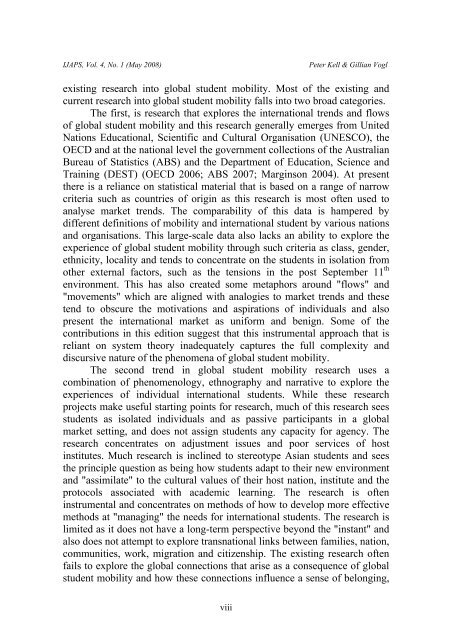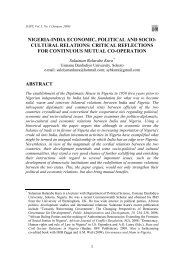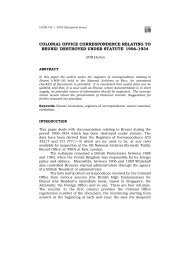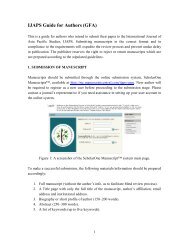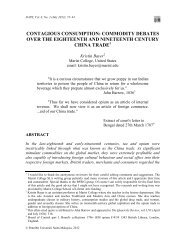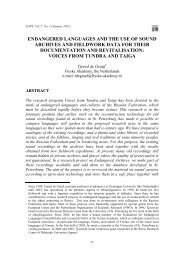This edition of the International Journal of Asia Pacific Studies ...
This edition of the International Journal of Asia Pacific Studies ...
This edition of the International Journal of Asia Pacific Studies ...
You also want an ePaper? Increase the reach of your titles
YUMPU automatically turns print PDFs into web optimized ePapers that Google loves.
IJAPS, Vol. 4, No. 1 (May 2008)Peter Kell & Gillian Voglexisting research into global student mobility. Most <strong>of</strong> <strong>the</strong> existing andcurrent research into global student mobility falls into two broad categories.The first, is research that explores <strong>the</strong> international trends and flows<strong>of</strong> global student mobility and this research generally emerges from UnitedNations Educational, Scientific and Cultural Organisation (UNESCO), <strong>the</strong>OECD and at <strong>the</strong> national level <strong>the</strong> government collections <strong>of</strong> <strong>the</strong> AustralianBureau <strong>of</strong> Statistics (ABS) and <strong>the</strong> Department <strong>of</strong> Education, Science andTraining (DEST) (OECD 2006; ABS 2007; Marginson 2004). At present<strong>the</strong>re is a reliance on statistical material that is based on a range <strong>of</strong> narrowcriteria such as countries <strong>of</strong> origin as this research is most <strong>of</strong>ten used toanalyse market trends. The comparability <strong>of</strong> this data is hampered bydifferent definitions <strong>of</strong> mobility and international student by various nationsand organisations. <strong>This</strong> large-scale data also lacks an ability to explore <strong>the</strong>experience <strong>of</strong> global student mobility through such criteria as class, gender,ethnicity, locality and tends to concentrate on <strong>the</strong> students in isolation fromo<strong>the</strong>r external factors, such as <strong>the</strong> tensions in <strong>the</strong> post September 11 <strong>the</strong>nvironment. <strong>This</strong> has also created some metaphors around "flows" and"movements" which are aligned with analogies to market trends and <strong>the</strong>setend to obscure <strong>the</strong> motivations and aspirations <strong>of</strong> individuals and alsopresent <strong>the</strong> international market as uniform and benign. Some <strong>of</strong> <strong>the</strong>contributions in this <strong>edition</strong> suggest that this instrumental approach that isreliant on system <strong>the</strong>ory inadequately captures <strong>the</strong> full complexity anddiscursive nature <strong>of</strong> <strong>the</strong> phenomena <strong>of</strong> global student mobility.The second trend in global student mobility research uses acombination <strong>of</strong> phenomenology, ethnography and narrative to explore <strong>the</strong>experiences <strong>of</strong> individual international students. While <strong>the</strong>se researchprojects make useful starting points for research, much <strong>of</strong> this research seesstudents as isolated individuals and as passive participants in a globalmarket setting, and does not assign students any capacity for agency. Theresearch concentrates on adjustment issues and poor services <strong>of</strong> hostinstitutes. Much research is inclined to stereotype <strong>Asia</strong>n students and sees<strong>the</strong> principle question as being how students adapt to <strong>the</strong>ir new environmentand "assimilate" to <strong>the</strong> cultural values <strong>of</strong> <strong>the</strong>ir host nation, institute and <strong>the</strong>protocols associated with academic learning. The research is <strong>of</strong>teninstrumental and concentrates on methods <strong>of</strong> how to develop more effectivemethods at "managing" <strong>the</strong> needs for international students. The research islimited as it does not have a long-term perspective beyond <strong>the</strong> "instant" andalso does not attempt to explore transnational links between families, nation,communities, work, migration and citizenship. The existing research <strong>of</strong>tenfails to explore <strong>the</strong> global connections that arise as a consequence <strong>of</strong> globalstudent mobility and how <strong>the</strong>se connections influence a sense <strong>of</strong> belonging,viii


